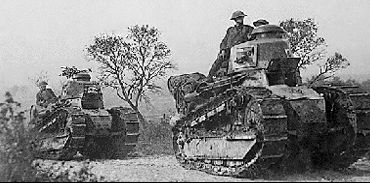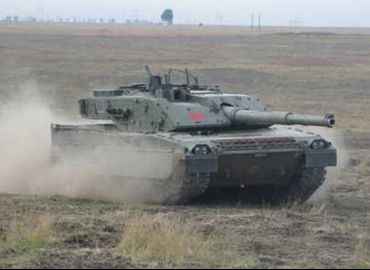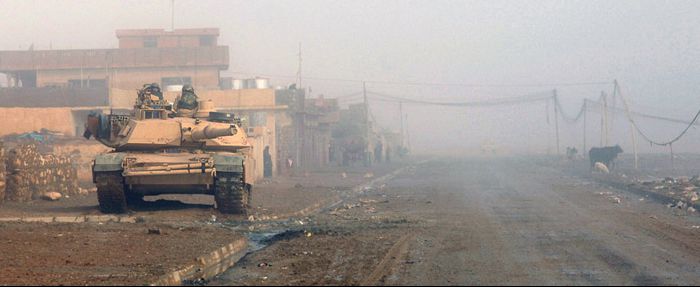The armored-armored component of the national military instrument, starting from October of the 1989, has started a path of alternating fortunes, connected to the better or worse economic situation of the moment in a succession of enthusiasm and demobilization.
This sinusoid derives from the fact that the conception, development and use of the heavy instrument, understood as a combination of human and mechanical component, integrated in procedures and tactics of use, have had the misfortune of having to continually compare themselves with market needs, industrial policies and media implications. The tank of the third millennium, according to an increasingly widespread vulgate, will have to be economically and socially sustainable to survive or cannot be, as regards the extent of this sustainability, it will be evaluated in terms of production costs, measurement of effects on the surrounding environment, war effectiveness and low impact on the civilian population involved in military actions.
It was probably easier for Guderian to summarize the performance and capabilities of the L-M-P wagons in the period between the two world wars by laying the foundations for what would later be the definition of the "main wagon" from battle ". Going beyond the boutade and wanting to go into the merits of this analysis, we can start from the assumption for which the armored-armored units are still today in a position to provide effective support to terrestrial military operations contributing significantly to the achievement of success.
A story of evolution and adaptation
In order to clarify what has been explained up to now, a brief historical excursus should be made to illustrate how the heavy component of the military land forces has been conceived, over time, as a resource and synthesis of technology and effectiveness, unfortunately often limited by the contraction of the scarcity of resources and significant burdens in terms of maintenance and direct and indirect logistical support.  Durante la fase finale del primo conflitto mondiale, il comando supremo italiano, sulla scorta delle esperienze inglesi e francesi occorse nelle campagne del fronte occidentale, ritenne fosse opportuno sperimentare i carri Shnider ed F17 Renault nel complesso scenario carsico.Caporetto prima e la vittoria poi sospesero temporaneamente l’evoluzione in termini di acquisizione e dottrina, tuttavia i risultati ottenuti in fase sperimentale vennero reputati più che buoni, anche se accompagnati da quello che nel futuro sarà il consueto contraltare, di cui si è già parzialmente trattato, connesso con la questione dei costi e della sostenibilità. Fu proprio il maggiore d’artiglieria conte Alfredo Bennicelli, inviato del comando supremo in Francia, nonché mentore circa l’acquisizione dei mezzi e della dottrina corazzata francese il primo ad evidenziare nella propria relazione la criticità connessa ai costi di tale tecnologia.A guerra finita tuttavia, il buon andamento delle prove pratiche svolte sul Carso fece sì che sperimentazione ed acquisizione avessero la meglio sulle ritrosie connesse agli oneri da sostenere, pertanto vennero fondati i reparti corazzati e le conseguenti dottrine di impiego. Queste nuove unità seppero adattarsi egregiamente agli scenari di riferimento dei decenni successivi quali la campagna d’Africa orientale, di Spagna ed il secondo conflitto mondiale, in un susseguirsi di esperienze ed evoluzione connesse con le lezioni apprese dalla condotta bellica. Nei contesti bellici si registrò la crescita dello strumento pesante in termini dottrinali e di impiego, a ciò si aggiunsero adeguamenti tecnici e procedurali per i quali le unità corazzate, prima della grande battaglia di El Alamein videro un significativo cambiamento in termini di impiego da semplice elemento di rottura e supporto alla manovra a vera e propria unità di manovra.Sebbene la sconfitta bellica abbia per certi aspetti frenato i processi di cambiamento e miglioramento in ambito nazionale, ciò non avvenne per altri Stati che ebbero modo di continuare a vivere l’efficacia dei cingoli nelle condotta delle operazioni.Corea e Vietnam, le guerre arabo - israeliane e la rincorsa tecnologica e dottrinale tra le due potenze continentali di USA e URSS, furono per tutta la seconda metà del novecento un ambiente estremamente fertile per lo sviluppo di nuove soluzioni tecnico - tattiche ed apprendimento in materia; quanto all’Italia, si inserì in modo dottrinalmente e tecnicamente aderente ai dettami dell’Alleanza Atlantica, a cui aveva aderito fin dal 1949, secondo un modello di sviluppo standardizzato ed integrato.La linea di demarcazione tra il passato eroico ed il pragmatismo tecnico del presente, nell’ottica di una rivitalizzazione in senso dinamico e non più di mero confronto in termini di peso specifico della componente blindo - corazzata, ci fu con il verificarsi della prima crisi del golfo nel 1990. Il primo grande scontro bellico convenzionale dopo la seconda guerra mondiale mostrò come l’esercito americano attraverso una componente corazzata, efficiente e ben impiegata sia stato in condizione di imprimere all’avversario perdite nell’ordine del 70% delle unità obiettivo, ciò non fu ovviamente frutto della casualità o di un confronto impari, ma della capacità di impiegare in maniera attagliata la componente corazzata allo scenario di riferimento sfruttando integralmente ed efficacemente le caratteristiche della formula tattica. A conclusione di tale breve analisi resta evidente che negli anni gli elementi cardine della componente corazzata siano stati la grande adattabilità ai vari scenari, la loro oggettiva evoluzione nel tempo ed un notevole onere in termini di acquisizione del mezzo, addestramento del personale e mantenimento della componente.
Durante la fase finale del primo conflitto mondiale, il comando supremo italiano, sulla scorta delle esperienze inglesi e francesi occorse nelle campagne del fronte occidentale, ritenne fosse opportuno sperimentare i carri Shnider ed F17 Renault nel complesso scenario carsico.Caporetto prima e la vittoria poi sospesero temporaneamente l’evoluzione in termini di acquisizione e dottrina, tuttavia i risultati ottenuti in fase sperimentale vennero reputati più che buoni, anche se accompagnati da quello che nel futuro sarà il consueto contraltare, di cui si è già parzialmente trattato, connesso con la questione dei costi e della sostenibilità. Fu proprio il maggiore d’artiglieria conte Alfredo Bennicelli, inviato del comando supremo in Francia, nonché mentore circa l’acquisizione dei mezzi e della dottrina corazzata francese il primo ad evidenziare nella propria relazione la criticità connessa ai costi di tale tecnologia.A guerra finita tuttavia, il buon andamento delle prove pratiche svolte sul Carso fece sì che sperimentazione ed acquisizione avessero la meglio sulle ritrosie connesse agli oneri da sostenere, pertanto vennero fondati i reparti corazzati e le conseguenti dottrine di impiego. Queste nuove unità seppero adattarsi egregiamente agli scenari di riferimento dei decenni successivi quali la campagna d’Africa orientale, di Spagna ed il secondo conflitto mondiale, in un susseguirsi di esperienze ed evoluzione connesse con le lezioni apprese dalla condotta bellica. Nei contesti bellici si registrò la crescita dello strumento pesante in termini dottrinali e di impiego, a ciò si aggiunsero adeguamenti tecnici e procedurali per i quali le unità corazzate, prima della grande battaglia di El Alamein videro un significativo cambiamento in termini di impiego da semplice elemento di rottura e supporto alla manovra a vera e propria unità di manovra.Sebbene la sconfitta bellica abbia per certi aspetti frenato i processi di cambiamento e miglioramento in ambito nazionale, ciò non avvenne per altri Stati che ebbero modo di continuare a vivere l’efficacia dei cingoli nelle condotta delle operazioni.Corea e Vietnam, le guerre arabo - israeliane e la rincorsa tecnologica e dottrinale tra le due potenze continentali di USA e URSS, furono per tutta la seconda metà del novecento un ambiente estremamente fertile per lo sviluppo di nuove soluzioni tecnico - tattiche ed apprendimento in materia; quanto all’Italia, si inserì in modo dottrinalmente e tecnicamente aderente ai dettami dell’Alleanza Atlantica, a cui aveva aderito fin dal 1949, secondo un modello di sviluppo standardizzato ed integrato.La linea di demarcazione tra il passato eroico ed il pragmatismo tecnico del presente, nell’ottica di una rivitalizzazione in senso dinamico e non più di mero confronto in termini di peso specifico della componente blindo - corazzata, ci fu con il verificarsi della prima crisi del golfo nel 1990. Il primo grande scontro bellico convenzionale dopo la seconda guerra mondiale mostrò come l’esercito americano attraverso una componente corazzata, efficiente e ben impiegata sia stato in condizione di imprimere all’avversario perdite nell’ordine del 70% delle unità obiettivo, ciò non fu ovviamente frutto della casualità o di un confronto impari, ma della capacità di impiegare in maniera attagliata la componente corazzata allo scenario di riferimento sfruttando integralmente ed efficacemente le caratteristiche della formula tattica. A conclusione di tale breve analisi resta evidente che negli anni gli elementi cardine della componente corazzata siano stati la grande adattabilità ai vari scenari, la loro oggettiva evoluzione nel tempo ed un notevole onere in termini di acquisizione del mezzo, addestramento del personale e mantenimento della componente.
The four conceptual pillars
The numerous CRO (Crisis Response Operations) operations developed following the overcoming of the Cold War and restructured in terms of employment and level of conflict, after the 11 September of the 2001, have led a large number of experts to believe that asymmetric threats and hybrids may suggest that the armored component has been superseded as a solver or even just a support element, with some effectiveness. Not having any opposing force symmetrically or beyond a curtain was a strong signal to which an answer was given equally decisive also in symbolic terms proceeding to dismantle or drastically reduce some reputed structures no longer necessary to the contingent need and even in part to the future prospects. In response to these choices, once again relentlessly, the ground intervened, with which every soldier he is forced to reckon. Specifically, the experience has shown, if there was still a need, an extreme adaptability of the heavy assets and the units connected to them, so much so that, even if it is anachronistic to think of the use of a homogeneous armored minor complex, the use of mixed units with more streamlined configurations, but in terms of protection and mobility much more prompt and effective than what can be expressed by light components, especially if we take into account the need to operate in sparsely inhabited areas and far from operational bases. with adequate protection for the crew and for the entire device and a firepower capable of eliminating the threat quickly and effectively, they ensure that the armored-armored system can once again be the protagonist with the appropriate adaptations. In this brief analysis the term system has been used since the heavy component by its very nature exists as a synthesis of man - doctrine - training and a means. It is precisely the system we have just stated that allows this component of the terrestrial forces to adapt and continuously evolve effectively, sometimes rediscovering some capabilities and in some cases creating new ones, just think of the fact that in the second Gulf crisis 2001, the Americans, who at first considered the armored instrument inadequate, in order to face the clashes asymmetrical typical of the post-conflict and subsequently had to change their mind by enhancing and exploiting the protection, deterrence and contribution to the security activity of the devices, intrinsic of the armored-armored instrument. The whole reasoning up to now has not taken into account the aspects financial and social, evaluated in terms of impact on public opinion, with which a component and so specific it must necessarily confront, it is certain that supporting a complex system such as the one composed of man - doctrine - training and means is onerous since it needs to manage four components, but this burden finds ample justification in the effectiveness of the tool, in fact an analysis costs cannot be said to be effective if they are not put into the system with the goodness of the effects that can be obtained as a result of the effort produced to sustain them.
Specifically, the experience has shown, if there was still a need, an extreme adaptability of the heavy assets and the units connected to them, so much so that, even if it is anachronistic to think of the use of a homogeneous armored minor complex, the use of mixed units with more streamlined configurations, but in terms of protection and mobility much more prompt and effective than what can be expressed by light components, especially if we take into account the need to operate in sparsely inhabited areas and far from operational bases. with adequate protection for the crew and for the entire device and a firepower capable of eliminating the threat quickly and effectively, they ensure that the armored-armored system can once again be the protagonist with the appropriate adaptations. In this brief analysis the term system has been used since the heavy component by its very nature exists as a synthesis of man - doctrine - training and a means. It is precisely the system we have just stated that allows this component of the terrestrial forces to adapt and continuously evolve effectively, sometimes rediscovering some capabilities and in some cases creating new ones, just think of the fact that in the second Gulf crisis 2001, the Americans, who at first considered the armored instrument inadequate, in order to face the clashes asymmetrical typical of the post-conflict and subsequently had to change their mind by enhancing and exploiting the protection, deterrence and contribution to the security activity of the devices, intrinsic of the armored-armored instrument. The whole reasoning up to now has not taken into account the aspects financial and social, evaluated in terms of impact on public opinion, with which a component and so specific it must necessarily confront, it is certain that supporting a complex system such as the one composed of man - doctrine - training and means is onerous since it needs to manage four components, but this burden finds ample justification in the effectiveness of the tool, in fact an analysis costs cannot be said to be effective if they are not put into the system with the goodness of the effects that can be obtained as a result of the effort produced to sustain them.
Comparisons and evaluations
In the common feeling, now shared also by analysts inside the defense, we discover how the panacea for all evils for a correct cost-effectiveness ratio is the VTLM lince, "genetically" acceptable because rotated, not excessively long and not too high, a survival cell capable of guaranteeing the protection of the crew following IED events and capable of being equipped with such armament as to provide fire support and protection. In the face of what has been described, however, the operational experience has shown how the protection of the vehicle, to be up to the tactical situations must sometimes be increased like the on-board weapon systems, without counting the need to use more than one vehicle for transporting team level units in an organic way, in short, in order to have a truly effective product, it is necessary to transform this excellent multi-role vehicle into a small "tank", thus distorting the VTLM of its characteristics and preventing the armored-armored component from evolving , risking, in the medium term, to witness the depletion of the armored-armored capacity. In a broad reasoning, this comparison between means of different types is not aimed at preferring one instead of another, but only at trying to make immediately understandable what has been explained up to now, namely that the heavy component is a necessary element of a terrestrial force in what makes it possible to carry out a series of missions that can hardly be carried out in any other way without exposing oneself to excessive risks or affecting success.
Conclusions
The terrestrial military instrument to which to hope must be characterized by an adequate level of technology, high credibility in terms of preparation, motivation and use of personnel, as well as sustainability, this finding finds full synthesis in the armored-armored component, defined as such, through appropriate adaptations that see first and foremost the quality of the system instead of the quantity of the vehicle, the heavy component can still be said to be the protagonist of the challenges of the future.
Andrea Pastore

(photo: EI, archive, General Dynamics)












